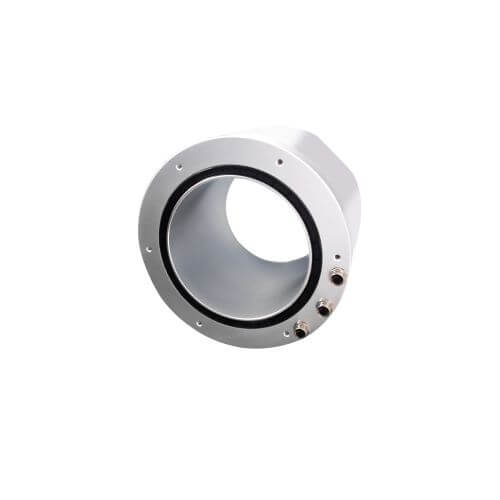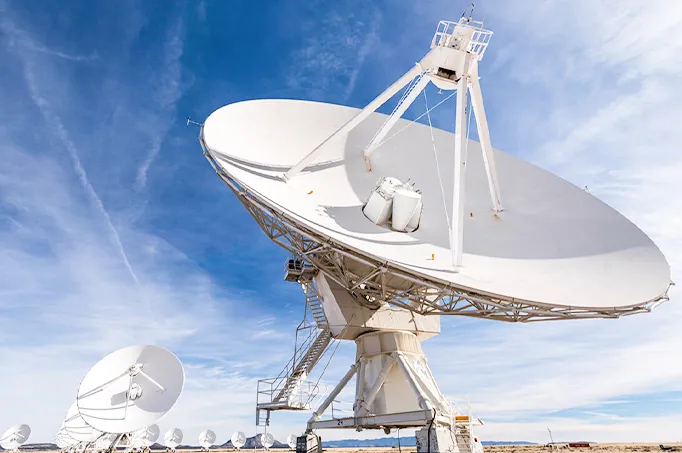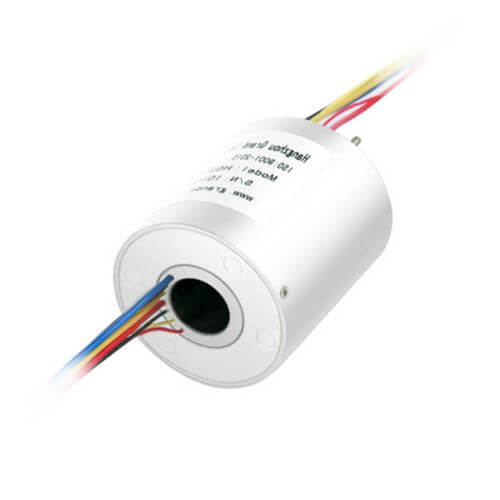This article delves into the world of electrical through hole slip rings by exploring their basic principles, construction, advantages, and practical applications. Gain valuable insights into the factors that can influence their performance, and learn how to effectively select, maintain, and troubleshoot these essential components for seamless power and signal transmission in rotating systems.
Introduction to Electrical Through Hole Slip Rings
Electrical through hole slip ring, also known as rotary electrical joints or rotatory connectors, are critical electromechanical devices developed to solve the challenges faced by power and signal transmission in rotating systems. These versatile components play an essential role in a wide range of applications, from heavy machinery to medical equipment and telecommunications, by providing a reliable solution for power and signal transmission between stationary and rotating parts. Understanding the fundamentals of electrical through hole slip rings, their working mechanisms, and their common uses will help users appreciate their significance in the modern world, where continuous and efficient rotational operations are a crucial requirement.
Electrical through hole slip rings use a combination of conductive brushes and tracks to transfer electrical power and signals betwixt a fixed part—called the stator—and a rotating part—called the rotor. The central hole through the slip ring permits the passage of cables, fluids, or even shafts, depending on the specific demands of the application. This unique design enables continuous rotation and electrical transmission, circumventing wire tangling or compromised signal integrity experienced when employing conventional cables and connectors.
Common applications of electrical through hole slip rings encompass industries such as renewable energy (notably wind turbines), medical imaging equipment, industrial automation, robotics, satellite communications, and even amusement rides. With these ubiquitous applications, it’s evident that electrical through hole slip rings form the backbone of numerous modern systems where rotational movement and dependable electrical connectivity are indispensable. By accurately learning about their roles and working principles, potential users and industry professionals can make well-informed decisions on selecting, implementing, and maintaining these crucial electromechanical components.
Throughout this article, we delve deeper into the design features of electrical through hole slip rings, their different types, key benefits, and limitations. Additionally, we will explore real-world applications and case studies showcasing their use in various industries. This comprehensive exploration aims to increase our understanding of the importance of electrical through hole slip rings and how they contribute to the functionality and efficiency of countless rotating systems today.

Electrical Through Hole Slip Rings Basics and Working Principle
Hole Slip Rings, otherwise known as rotary electrical joints, are unique in engineering for their role in facilitating the transmission of power and electrical signals between stationary and rotating parts. They present an elegant and effective solution to the daunting problem often encountered in many rotational systems: how to maintain continuous electrical transmission without hindrance from twisting and tangling of wires.
Let’s simplify the basics of electrical through hole slip ring operation—it all boils down to two main components: the rotor and the stator. The rotor, as the name implies, rotates along an axis, while the stator remains stationary. The coupling of these two components creates an interface that allows electrical signals and power to be relayed from stationary sources to rotating components.
Drilling down further, we find that the rotor and stator are not in direct contact but communicate via conductive brushes (typically made of precious metals like gold or silver for their superior conductive properties) that softly brush against conductive circuits (or tracks) placed around the circumference of the rotor. It is this fine act of brushing against each other that forms the basis of transmitting signals and power from the stationary to the rotational component. Remarkably, this is all made possible while maintaining the integrity of the connection and ensuring a smooth, unhindered rotation.
Adding to the engineering prowess of these slip rings is the ‘through hole’ design element. The ‘hole’ in a through hole slip ring allows for the passage of a central shaft or other interconnections, offering more flexibility in design and application. This feature leads to expanded functionality and facilitates integration into a variety of machinery and devices.
Through this unique design combination and operation, through hole slip rings have effectively solved the enduring problem of cable twisting in countless rotational applications. Whether in a satellite aiming for continuous rotation while upholding seamless communication, a wind turbine facing challenging environmental conditions, or a medical imaging device needing reliable data transmission while scanning a patient, electrical through hole slip rings to ensure smooth, continuous, and reliable power and signal transmission.
In essence, the working principle behind electrical through hole slip rings represents a fine balance of mechanical and electrical engineering coupled with innovative design, delivering continuous, unaltered power, and signal transmission for an array of critical rotating applications. We’ll explore the further complexity and variety of these versatile devices as we move forward with our comprehensive overview.
Electrical Through Hole Slip Rings Construction and Design Features
Understanding the intricacies of electrical through hole slip rings requires an appreciation of their construction and design features, which together drive their reliable performance in various applications. Each component is thoughtfully designed to ensure seamless power and signal transmission between stationary and rotating components within a machine or system.
- Central Hole
At the heart of every through hole slip ring lies the central hole, the design element that gives the device its name. This hole can accommodate different components, including cables, pneumatic or hydraulic lines, and drive shafts, depending on the specific requirements of the application. This design feature allows for unparalleled versatility and adaptability in various installations.
- Rotor and Stator
The rotor and stator form the core of the slip ring’s operation. They work in unison but serve distinct functions with the rotor rotating and the stator remaining stationary. The rotor carries the conductive rings that serve as the transmission path for power and signals, while the stator houses the brush assembly responsible for connecting to the stationary circuit and maintaining electrical contact with the spinning rotor.
- Conductive Tracks
Conductive tracks, mounted on the rotor, are the primary path for the flow of electrical signals and power within the slip ring. The number and layout of these tracks can be customized based on various parameters, including signal types, power requirements, and data transmission needs. They are often crafted from highly conductive and durable materials to endure regular contact with brushes and ensure a consistent transfer of power and signals.
- Brushes
Brushes are small conductive components that maintain contact with the conductive tracks on the rotating rotor. Typically designed from precious metals such as gold, silver, or their alloys due to their superior conductivity and low-resistance properties, brushes play an essential role in transferring power and signals from the stationary circuit onto the rotating component.
- Bearings
Bearings facilitate the smooth and low-resistance rotation of the rotor within the slip ring assembly. They are designed to withstand the rotational speed and load of the specific application to protect the slip ring from mechanical failures. High-quality bearings contribute to the slip ring’s lifespan, reducing operational noise and ensuring smooth rotation over prolonged periods.
- Housing
The housing serves to protect the intricate internal components of the slip ring from environmental influences such as dust, moisture, and vibrations. Depending on the installation conditions and operational demands, the housings can be built from engineering plastics, aluminum, stainless steel, or other materials renowned for their robustness and ability to withstand tough environmental conditions.
Together, these diverse components form a complex yet effective ecosystem within electrical through hole slip rings, allowing them to function efficiently and robustly even in challenging operational environments. The understanding of these construction and design features ultimately enables engineers and technical experts to select, maintain, and troubleshoot these devices more effectively, thereby ensuring their operational longevity and reliability.
Types of Electrical Through Hole Slip Rings
As versatile and adaptable components, electrical through hole slip rings come in a wide array of types, each designed keeping specific requirements and applications in mind. Some of these variations include size, material choices, transmission capacity, and working speed. This section focuses on outlining some of the most commonplace types of through hole slip rings, detailing their distinct features and typical applications.
- Standard Through Hole Slip Rings
These are the most commonly encountered types of electrical through hole slip rings. With a universal design to cater to a broad range of applications, these slip rings typically have a balance of power and signal transmission capabilities, making them compatible with various signal types and power requirements. Their central hole can accommodate shaft mounting or pass-through connections, adding to their versatility. Applications range from industrial automation equipment, and CCTV systems, to amusement rides.
- High-Speed Through Hole Slip Rings
Specially designed to cater to applications with fast rotational operations, these slip rings uphold a high level of signal integrity and a low level of electrical noise even at high speeds. A 700mm through hole custom slip ring is an ideal solution for such applications, offering the ability to handle larger diameters while maintaining performance under high-speed conditions. These custom slip rings typically incorporate advanced brush technology and specialized materials to withstand the increased stresses linked with high rotational speeds. Typical applications encompass servo mechanisms, testing equipment, radar antennas, and other systems where a 700mm through hole custom slip ring can provide reliable power and signal transmission while meeting the unique requirements of high-speed rotation.
- High-Current Through Hole Slip Rings
These are built to withstand and perform reliably under high-power applications. Characterized by robust construction, high-quality conductive materials, and the ability to handle exceptional current loads, these are the go-to choice for applications that require high-power transmission. Commonly used in wind turbines, electric vehicles, and heavy machinery.
- Ethernet Through Hole Slip Rings
Rooted in the age of digital connectivity, these slip rings provide reliable signals for Ethernet communications. They integrate specific components, such as transformers and additional shielding, to maintain signal integrity and reduce electrical noise, providing a smooth data transmission process. They often find their place in modern machinery, CCTV systems, and robots where real-time, high-speed data transmission is crucial.
- Fiber Optic Rotary Joints (FORJs)
A specialized type of slip ring, where instead of traditional conductive tracks and brushes, they use optical fibers to transmit signals. With virtually no limit on the amount of data they can transmit, they are typically used for high-speed data, video, and sensor signal transmission in applications like radar systems, cable reels, remote-operated vehicles (ROVs), and more.
In essence, the wide variety of electrical through hole slip rings accounts for a plethora of requirements and applications, making it crucial to understand these types to make an accurate and efficient selection based on individual requirements. Each offers unique capabilities to cater to specific operational parameters, ensuring reliable power and signal transmission across various industries and applications.
Electrical Through Hole Slip Rings Key Benefits and Potential Limitations
Electrical through hole slip rings, with their unique operational mechanisms and versatile designs, have made a mark in various sectors due to their unique benefits. However, as with any device, they, too, are subject to certain limitations. An understanding of both benefits and limitations ensures an informed decision when considering these innovative components for different applications.
Key Benefits
- Continuous Transfer:
Electrical through hole slip rings allow for the consistent, uninterrupted transfer of power, signals, and data between stationary structures and rotating elements. They solve the problem of wire tangling and twisted cables in environments involving constant rotation.
- Versatility:
They come in a wide range of sizes, materials, and specifications, making them applicable for a variety of industries – from military and aerospace applications to medical technology and consumer electronics.
- Design Flexibility:
The central ‘through-hole’ design offers the flexibility to mount them on a shaft or allow passage for other connections, enhancing the overall adaptability for a wide range of systems.
- Robust and Durable
Carefully selected materials, combined with advanced engineering designs, ensure that these slip rings can operate accurately and reliably even in harsh and challenging environments.
Potential Limitations
- Limited Lifespan:
Unlike stationary connections, these slip rings incorporate moving parts. The brushes contacting the conductive tracks on the rotor undergo wear and tear during the lifespan of the device, which may limit its operation duration.
- Maintenance Requirement
Regular maintenance and inspection of the slip rings can be necessary, particularly in high-speed or high-current usage scenarios, where there’s a higher degree of wear and tear.
- Environment Sensitivity
While slip rings have a robust construction, exposure to extreme environmental conditions such as extremely high temperatures, dust, or corrosive elements can pose challenges to their optimal functionality.
- Cost Considerations
Depending on the precise specifications required – including the number of circuits, type of signal transmission, and rotational speed – slip rings can sometimes be a high initial investment, particularly when compared to stationary cable connections.
Through hole slip rings have fundamentally redefined how electrical connections can be maintained and managed in rotating systems. However, understanding the balance of their benefits and potential limitations is crucial to unearthing their true potential and the extent to which they can be exploited for specific applications.
Electrical Through Hole Slip Rings Real-world Applications and Case Studies
The versatile nature of electrical through hole slip rings allows them to find utility in a wide range of industries, both in typical and unusual applications. Here are a few representative real-world examples that illustrate the practical use of these devices.
- Wind Energy Industry
In wind turbines, a substantial amount of data and power need to be transferred from the stationary tower to the rotating blades and the generator. High-current through hole slip rings enable this necessary transmission of power and signals, allowing for necessary adjustments of blade pitch and continuous power generation.
Case Study: Moog’s large pitch control slip ring assembly is used in wind turbines globally. Its customized design, robust build, and incorporation of innovative fiber brush technology offer longevity and reliable performance, significantly reducing the maintenance needs and operational costs of these renewable energy facilities.

- Medical Industry
Medical imaging systems, especially CT scanners, require smooth and consistent transmission of power and data between the stationary equipment and the rotating gantry. High-speed through hole slip rings in CT scanners ensure the seamless transmission of data from the rotating X-ray tubes and detectors to the stationary computers for processing and image generation.
Case Study: Through hole slip rings from Mercotac have been used by CT machine manufacturers worldwide. These slip rings provide reliable, low-noise data transmission that contributes to the high-quality, real-time imaging necessary for precise diagnoses and treatments.
- Military & Defense Industry
In radar antennas systems, consistent rotation is necessary to monitor a wide field of vision. Ethernet through hole slip rings enables the seamless transfer of data and power between stationary and rotating components, ensuring uninterrupted functionality and real-time data delivery.
Case Study: Cobham’s slip rings have been used in military radar systems across the globe, propagating real-time data transmission without loss or interruption. Through their robust design and advanced technology, they effectively handle the harsh environmental conditions typical of military applications.

- Manufacturing Industry
Modern manufacturing units often leverage robotic arms for accurate and efficient assembly lines. These robotic arms require the uninterrupted transmission of power and signals for smooth operation. Through hole slip rings enable this continuity, promoting higher productivity and reduced downtime.
Case Study: DSTI’s through hole slip rings have been integrated into many industrial robot applications, allowing robots to move freely without cable restraints, thereby enhancing assembly line efficiency and productivity.

In conclusion, electrical through hole slip rings have been instrumental in driving innovations and facilitating operational efficiency across a host of industries worldwide. These case studies offer a glimpse into their many applications and their potential to transform the way we approach power and data transmission challenges in diverse fields.
Factors Influencing the Performance of Electrical Through Hole Slip Rings
The operational effectiveness and lifespan of electrical through hole slip rings can be influenced by a host of factors, ranging from their operating environment, and implemented maintenance practices, to specific operational parameters. It is crucial to understand and account for these factors to ensure optimal performance and durability.
Environmental Factors
- Temperature: Extreme temperatures can affect the performance of slip rings. Higher temperatures can cause thermal expansion, which may distort the positioning of the components and affect transmission. On the contrary, extremely low temperatures can impact the material characteristics, thus influencing the overall performance.
- Humidity: High moisture levels can lead to corrosion thereby reducing the effectiveness and lifespan of the slip ring.
- Dust and Debris: If dust and debris get into the tracks and brushes, it could cause increased friction, and wear and tear, which can consequently impact the signal transmission.
Operational Parameters
- Rotational Speed: High rotational speeds increase friction between the brushes and the rotating tracks, leading to faster wear and tear, thereby affecting the lifespan of the slip ring.
- Electrical Load: Slip rings designed for specific electrical load limits should not be overloaded as this could result in overheating and potential damage, affecting both their performance and durability.
- Vibration and Shock: Excessive vibration or shock can disrupt the physical engagement between the brushes and the rings, affecting the quality of transmission, and possibly damaging the components.
Maintenance Practices
Regular cleaning and inspection of the slip rings can considerably extend their lifespan. Negligence in this aspect can lead to the build-up of dirt and debris, causing increased friction, wear, and even disruptions in the signal transmission.
Furthermore, replacing worn-out components, particularly the brushes, in a timely fashion can help maintain the performance and extend the useful life of the slip ring.
In summary, understanding these influencing factors can significantly contribute to maximizing the performance and lifespan of electrical through hole slip rings. Adequate consideration of these factors during the design, application, and maintenance stages can ensure the optimal operation of these crucial components in various industries and applications.
Electrical Through Hole Slip Rings Considerations for Selection
Choosing the right electrical through hole slip ring can often be a nuanced process, involving a consideration of several factors that relate not only to the device itself but also to its intended application and operating environment. Below are some of the key aspects to ponder when selecting an appropriate slip ring.
- Application
Understanding the specific application for the slip ring is the first and foremost consideration. This includes knowing whether the slip ring will be utilized for transmitting power, signals, or data. Distinct requirements, such as high-speed data transmission, may necessitate a specialized slip ring such as an Ethernet or fiber optic variant.
- Load Capacity
It’s essential to have a clear understanding of the amount and type of load the slip ring will be expected to manage. High-current applications will require a slip ring designed to handle increased power transmission, while applications involving delicate signals may require a slip ring designed for low noise and signal integrity.
- Environmental Conditions
The environmental conditions in which the slip ring will operate play a significant role in the selection. Factors include exposure to dust, extreme temperatures, vibrations, or corrosive elements. These conditions may demand slip rings that are sealed, have specific temperature tolerances, or are made from corrosion-resistant materials.
- Hole Dimensions
The requisite size of the through hole in the slip ring will be dictated by what it needs to accommodate, such as a shaft or additional connections. This determination involves not just the diameter, but also the length of the slip ring that may be restricted by the available space.
- Working Speed
The rotational speed at which the system operates must be factored into the selection, as high-speed applications may require slip rings designed to manage increased wear and tear and to maintain signal integrity under such conditions.
- Lifespan and Maintenance
It’s important to consider the desired lifespan and allowed maintenance frequency for the slip ring. Some slip rings are designed for long-term, high-durability use with minimal maintenance, while others might need more regular inspection and part replacements.
In conclusion, the process of choosing an electrical through hole slip ring involves a thorough understanding of the intended application’s operational parameters and environmental conditions. Considering each of these factors will ensure a slip ring that fits the needs and enhances the efficiency and reliability of the system in operation.
Electrical Through Hole Slip Rings Prominent Manufacturers and Products
| No. | Manufacturer | Website |
|---|---|---|
| 1 | Hangzhou Grand Technology | https://www.grandslipring.com/ |
| 2 | Moog Inc. | https://www.moog.com/ |
| 3 | Stemmann-Technik | https://www.stemmann.com/en/home |
| 4 | Schleifring | https://www.schleifring.com/ |
Hangzhou Grand Technology

Hangzhou Grand Technology Co., Ltd. started as a special slip ring manufacturer in 2011. Grown into slip rings, rotary joints, and slip ring assembly experts of today with 6,000 square meter manufacture complex.
Obtained ISO9001, Rosh, CE, and GJB9001B certificates a number of slip rings, rotary joint patents, and proud of our products can meet military grade. Collaborated with universities, institutes, and renowned factories across Asia and Europe including Panasonic, SIEMENS, CSIC, SAMSUNG, HUAWEI, etc.
Moog Inc.
Moog is a leading supplier of high-performance slip rings for various industries, including aerospace. Among their offerings, Moog’s SR Series Slip Rings are designed for the demanding environments of helicopters, excelling in performance, reliability, and customization potential.
Stemmann-Technik
Stemmann-Technik, a part of the Conductix-Wampfler Group, offers a broad range of slip rings, including solutions for helicopters. Their Livietta Slip Ring Assemblies are designed explicitly for harsh and demanding environments in the aviation sector, providing reliable signal and power transmission.
Schleifring
Schleifring is a well-known manufacturer of electromechanical systems, including slip rings customized for various industries. Their Aircraft Slip Rings cater specifically to helicopters, offering robust performance, low wear, and high reliability to meet the challenges of aviation applications.
If you want to know more about other slip ring manufacturers, you can read Top 10 Slip Ring Manufacturers in China, Top 10 Slip Ring Manufacturers In the USA Market 2023, and Top 10 Slip Ring Industry Key Manufacturers 2023.
Electrical Through Hole Slip Rings Maintenance, Troubleshooting, and Safety Measures
The use and operation of electrical through hole slip rings necessitate meticulous maintenance practices, vital troubleshooting knowledge, and adherence to safety measures. The following sections delve into these aspects in detail.
Maintenance
Regular maintenance is key to enhancing the lifespan and performance of the slip rings.
- Regular Cleaning: Dirt and debris should be regularly cleaned from the slip ring to avoid friction, wear, and tear.
- Lubrication: Proper lubrication is essential to reduce friction and prevent wear, thus ensuring smooth operation and extended lifespan.
- Component Replacement: Worn-out components, especially brushes, should be replaced promptly to prevent interruption of signal integrity.
Troubleshooting
Here are common issues and their possible solutions:
- Poor Signal Transmission: This could be due to worn brushes or accumulation of debris. Regular cleaning and component replacement as required can solve this issue.
- Overheating: Overheating can be caused by overload or friction due to lack of lubrication. Ensuring the slip ring is not overloaded and properly lubricated can prevent overheating.
- Noise: High noise levels could be attributed to worn-out components or insufficient contact between brushes and rings. Replacement of worn parts and ensuring good contact can resolve this issue.
Safety Measures
Working with slip rings demands careful adherence to safety measures to prevent accidents and injuries.
- Personal Safety: It’s crucial to use protective equipment, like gloves and safety glasses, when maintaining or troubleshooting the device.
- Equipment Handling: Only qualified personnel should handle maintenance and troubleshooting tasks as these require an understanding of electrical systems.
- Power Safety: Always ensure to turn off and unplug the system from power sources while conducting any work on the device.
- Overload Protection: Implementing adequate overload protection measures will prevent damaging the slip ring or causing an electrical fire.
In conclusion, the maintenance, troubleshooting, and safety of electrical through hole slip rings require substantial attention. Ignoring these aspects could lead to inefficient performance, premature failures, and potential accidents, whereas careful adherence to the guidelines can ensure operational efficiency, longevity, and safety in the usage of these devices.
Electrical Through Hole Slip Rings Future Trends and Market Forecast
The field of electrical through hole slip rings is a constantly evolving one, shaped by the interplay of advancements in technology, changes in industry requirements, and shifting market conditions. The following section details the forecasted trends in this sphere and provides an outlook on what to expect in the years ahead.
- Miniaturization: With technology becoming smaller and smarter, the trend towards slip rings with minimal size but maximized performance is likely to continue. This ensures more compact designs in a variety of industrial applications.
- Increased Data Transmission Capacities: As industries rely more on data and less on power for their operations, there is an anticipated increased demand for slip rings capable of efficient high-speed data transmission.
- Integration of Advanced Materials: The use of advanced materials such as high-performance alloys or ceramics can improve durability, resistance to environmental elements, and overall performance of slip rings.
- Smart Slip Rings: With the rise of the Internet of Things (IoT), ‘smart’ slip rings, capable of monitoring their wear and tear, and even alerting control systems to needed maintenance, may become more prevalent.
- Market Forecast
The market for electrical through hole slip rings is predicted to grow steadily in the coming years.
- Industrial/Manufacturing Sector: From robotics to automated production lines, the demand for efficient and durable slip rings in the industrial sector is forecast to drive substantial growth.
- Renewable Energy: As renewable energy generation takes center stage, the use of slip rings in wind turbines and other machinery is expected to rise significantly.
- Communication: With an ever-increasing demand for seamless data transmission in multiple fields including medical, military, and telecommunications, the market prospects remain strong in these sectors.
In summary, the future of electrical through hole slip rings looks promising, driven by technological advancement, evolving industrial requirements, and projections of strong market growth. It’s fascinating to imagine how these trends will shape the electro-mechanical landscape, making electrical transmission more efficient, reliable, and adaptable.
Conclusion
Electrical through hole slip rings play an essential role in a wide range of applications by allowing seamless power and signal transmission. Understanding their design, function, and maintenance requirements ensures optimal performance, reliability, and longevity in various industrial and commercial applications.
See What We Can Do

